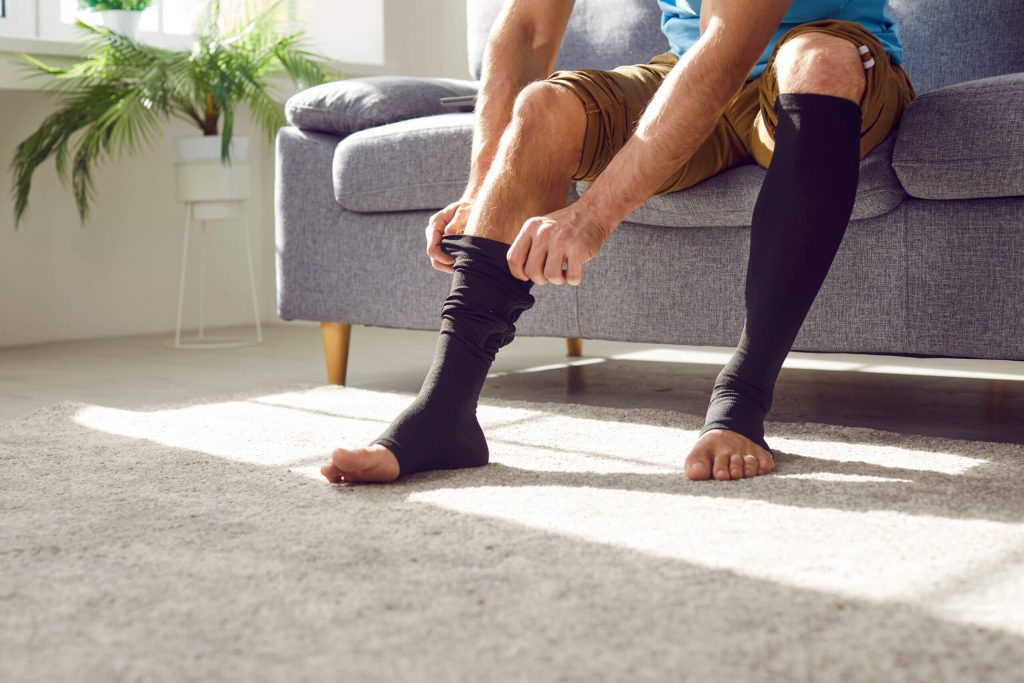If you live an active lifestyle, injuries are pretty much always an unfortunate part of life. Still, whether it’s a twisted ankle, a pulled muscle, or soreness from overtraining, having to adjust your exercise schedule or normal daily routine can feel frustrating. The good news? There are basic ways to treat common injuries right at home, and one of the most under-utilized tools in your recovery toolbox is compression.
What happens after you get injured?
Our bodies have a sophisticated healing process that’s almost always active in some form or another, but especially after an injury. However, sometimes this process needs a little extra support—especially around joints like the knee, shoulder, or elbow, where complex movements and highly specific stresses can slow recovery.
The natural healing process
When you’re injured, two key processes begin immediately:
- Inflammation: The body sends blood at an increased rate to the injury site, carrying nutrients and white blood cells to heal the tissue and fight infection. This is a necessary part of healing, but too much swelling can cause discomfort and even slow the healing process.
- Repair and regeneration: Over time, new cells grow to replace damaged tissue in the injured area. However, this process is delicate. Excessive movement or pressure on the area can hinder progress.
Joints, soft tissues, and bones all heal differently, and certain injuries may benefit from the additional protection and stabilization that compression can provide:
- Soft tissue injuries (like sprains, strains, and muscle pulls): These injuries often swell significantly and can benefit from compression to reduce swelling and bruising.
- Fractures (broken bones): Immobilization is typically most important for healing, but controlled compression can sometimes help improve blood flow.
- Surface-level injuries (like scrapes): While compression isn’t necessary here, keeping the area clean and protected is key.
Why is compression good for injuries?
If you’ve ever followed the RICE protocol (Rest, Ice, Compression, Elevation), you’ll know that compression is part of the rule of thumb for at-home healing treatments. But why does compression help injuries so much?
Here are some key benefits compression provides during the healing process:
Reduces swelling and bruising
Swelling is a natural part of the healing process, but it can sometimes lead to pain and stiffness. Compression helps reduce excessive buildup of fluid around the injury site, controlling swelling more effectively. This can also alleviate any pressure on nerves, which contributes to pain relief.
Improves blood circulation
Proper blood flow is crucial for repairing damaged tissue. Compression helps by gently applying even pressure throughout the affected area to improve circulation, ensuring that oxygen and nutrients can move efficiently to the injured area while helping waste products, like lactic acid, clear out faster.
Provides support and stability
Keeping an injury stabilized is important to prevent further damage. Compression garments or wraps help provide light support without restricting movement completely, making them ideal for soft-tissue injuries like muscle strains or sprains.
May alleviate pain
Many fitness enthusiasts or others who regularly utilize compression during recovery report that compression helps reduce pain. This may be due to the pressure limiting swelling and stabilizing injured areas, which in turn reduces discomfort caused by movement or inflammation.
How to use compression to heal an injury
Using compression effectively often involves combining it with other at-home care methods, depending on the type and severity of your injury. Here’s how to get started:
Step 1: Choose the right compression product
Compression garments range from sleeves and socks to wraps and full-body clothing. Select one designed for the specific area you’ve injured (e.g., compression knee sleeves for a knee injury). Look for a snug fit, but avoid anything so tight that it cuts off circulation or feels uncomfortable.
Step 2: Apply compression immediately after injury
For the best results, apply compression as soon as possible after the injury occurs. Gently wrap or wear the garment around the affected area to start addressing swelling and inflammation, as well as to remind yourself (if the pain isn’t doing so on its own!) that you have hurt that part of your body.
Step 3: Use intermittently (but consistently)
Instead of wearing compression 24/7, aim for intermittent use throughout the day. Alternate 2-3 hours of compression with periods of rest to prevent any excessive pressure on the area and encourage normal circulation.
Step 4: Monitor Progress
Pay close attention to how your body responds to the use of a compression garment. If swelling or discomfort persists despite consistent use, it might be time to seek professional help.
Expert guidance on at-home injury remedies
While compression can work wonders for many common injuries, some situations call for expert advice and treatment. If your injury isn’t improving after a few days of at-home care, or if you’re experiencing severe pain, reduced mobility, or instability in a joint, a physical therapist can help.
For folks in the Vancouver and NW Washington state area, Whatcom’s physical therapists are here to help you recover from any injury and return to the lifestyle you want to lead. Learn more about what might be the most effective strategy for healing your injury both quickly and for the long-term by calling one of our clinic locations or by requesting an appointment online today.
